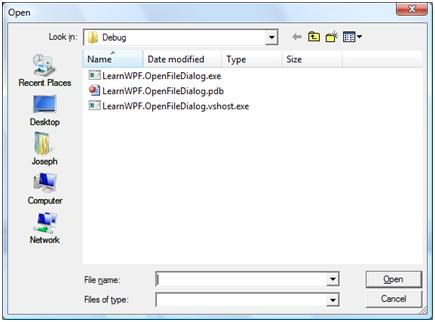Wpf Openfiledialog Vista Style

Hi, It is a well known fact that if you use the Microsoft.Win32.OpenFileDialog from an WPF application you will have old fashioned buttons and icons. The proposed solution to this problem (at least for ClickOnce applications) is to put a certain paragraph into the.exe.manifest file : Other options proposed are: Try to use EnableVisualStyles where people assume that this is not stable (SEHExceptions problems?).
Once you click the Open file button, the OpenFileDialog. Right after initializing the dialog, like this: openFileDialog. Using the OpenFileDialog in WPF is. Sep 05, 2010 Which open file dialog should be used for a wpf application. That should run on xp, vista and 7?
Or implement the dialog yourself by using a 'Vista Bridge' sample from the Windows SDK, which probably works only on Vista systems. Howerver, the majority votes for the manifest solution, but there seems to be a serious drawback: On Windows XP 64 bit versions, there is no version of Common Controls that matches this entry in the manifest file. There are wow64 and amd64 versions of CommonControls 6.0.x available but for applications compiled for 32 bit none of them can be used. Make faces sketchup plugin.

For 32 bit applications, only version 5.8.x is available which makes it very risky to use the above mentioned entry in the manifest file because the ClickOnce application will crash at install time. Is there really no better solution to display decent OpenFileDialogs in WPF? Best regards, Stefanie. Stefanie, Could you try using this in your manifest Note the processorArchitecture value., this instructs fusion to find a correct match in WinSxS. If this doesn't work (it does for me), could you try with WinSxS tracing (SxSTrace.exe) enabled and inspect the output of the parsed trace file.
Click to expand.Do you have any specific requirement to introduce the Forms assembly in a WPF application? I'm using Microsoft.Win32.OpenFileDialog from the PresentationFramework assembly, which is the WPF wrapper around the native Common Control (version specified through the manifest).

And here is the relevant part of the manifest I'm using. Note: I'm running this on Vista 64-bit and W2K3 64-bit SP2. Click to expand. Stefanie, Yes I do, but as I said before I tried this on Vista-64 W2K3 SP2 and W2K8-64 only, XP64 is quite a bit older, so I wouldn't be surprised that the manifest schema has changed a bit.
The documented behavior can be found here: Pay special attention to the following note: Important If you write an application for the 64 bit Windows platform, you must change the processorArchitecture entry to processorArchitecture='amd64'. You can also specify '.' , which ensures that all platforms are targeted. Note that. is actually the only value that works for managed applications built with Target platform 'Any CPU'. Any CPU (that is, MSIL ) means that the application can run on X86 or X64 or IA64, however, the manifest needs a compatible processorArchitecture for the common controls library (native code!!). ProcessorArchitecture='X86' will fail when running on X64, X64 will fail when you run on X86, so, the only valid value in this case is '.'
Download Free Windows Xp Themes Vista Style
. Following are the valid combinations: Target Platform processorArchitecture X86 X86 or. X64 X64 or. Itanium IA64 or. Any CPU. Again, I would suggest you to file a bug to Connect.